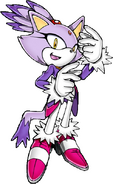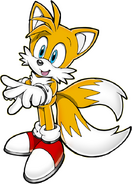
Sonic Rush (ソニック・ラッシュ Sonikku Rasshu?) is a platform handheld video game in the Sonic the Hedgehog series for the Nintendo DS. The game was released on November 2005 and was developed by Dimps and Sonic Team. The game capitalizes on the 'dual screen' aspect of the Nintendo DS in multiple ways, utilizing two screens as one extended vertical screen for very steep climbs and drops. Sonic Rush centers around two parallel universes colliding, featuring Sonic the Hedgehog and a new character, Blaze the Cat. They respectively battle Dr. Eggman and a new foe named Dr. Eggman Nega.
Designed as a 2.5D side-scroller, Sonic Rush is the first game in the Sonic series to explore both 2D and 3D venues by combining two-dimensional environments with three-dimensional models. In 2007, the game received a sequel, Sonic Rush Adventure.
Gameplay[]
Sonic Rush is a 2D platformer game, similar to earlier games in the series as well as later ones like Sonic Advance. The player controls either Sonic the Hedgehog or Blaze the Cat (Blaze becomes playable after defeating the Egg Hammer Mega in Sonic's story). Each character may differ in terms of abilities, but share otherwise similar moves for exploration and combat. In the tradition of past Sonic games, the goal is to reach the end of each Act of a Zone (a level in the game) in ten minutes. During regular Acts, both of the Nintendo DS's screens are used to display the area, with the playable characters moving between them when they reach certain heights or depths. After clearing the Boss Act, the progress is saved automatically and the player can proceed to the next Zone.
A new feature introduced in Sonic Rush is the "Tension Gauge" mechanic. The energy it generates allows the player to use the Super Boost and Fire Boost for Sonic and Blaze respectively, new abilities debuting in this game which give them a boost in speed while moving and lets them plow through enemies and obstacles without harm. When overcharged, the Tension Gauge has unlimited energy for a short time. The Tension Gauge is filled by performing Trick Actions, defeating enemies, passing Checkpoints and certain power-ups. The first method is an expansion of the Mid-Air Trick Actions introduced in Sonic Advance 2, and allows the playable characters to pulls off acrobatic stunts on Grind Rails or when sent flying into midair by gimmicks like Springs or Jump Panels. Performs such trick combos lets the player rank up energy for the Tension Gauge and points. Certain tricks also enable wider aerial movements. However, they will fail if interrupted.
Sonic Rush also introduces the Ranking system from the console Sonic titles on the handheld for the first time. After completing an Act, the player receives a rank (C being the lowest and S being the highest) based on the total Time, Trick, Ring and Speed Bonuses in the Act.
The player can collect Rings as a form of health. Like the traditional Rings, they give an extra life after collecting 100 of them, award points, and protect the player from damage. When taking damage, the player will drop all their Rings. However, a unique mechanic in this game compared to previous 2D games is that the more the player gets hit, the further the Rings will scatter. Taking damage without any Rings at all will cost the player a life. The player will also lose a life if the playable character spends too long underwater without replenishing their air supply (air underwater lasts for 18 seconds), falls into a bottomless pit, gets crushed or runs out of time. Losing a life makes the player start from the last Checkpoint they passed, or from the beginning of the Act if they have not passed any Checkpoints. If a character loses a life when the number of tries remaining is zero, the game is over. Aside from Rings, Sonic Rush also features Item Boxes and their balloon variants which contain the classical power-ups. The game introduces as well the Tension Bonus and Max Tension Bonus power-ups which can fill up the Tension Gauge.
Although Sonic Rush is primarily two-dimensional, it also incorporates three-dimensional elements to create a 2.5D effect. This is presented in the Acts focusing on 2D side-scrolling action with multiple sections containing gimmicks rendered in 3D, along with Sonic and Blaze's having 3D models as well. Each Zone's Boss Act is also entirely 3D, where Blaze fights Dr. Eggman and Sonic fights Eggman's doppelganger Eggman Nega. The game features as well Special Stages in 3D exclusive to Sonic which he can access via Special Generators in order to obtain the Chaos Emeralds.
As the characters' stories progress, they meet each other several times and unite in the final Zone that comes after the seventh. Noticeably, Blaze earns Sol Emeralds throughout her story's default Boss Acts, unlike Sonic and the Chaos Emeralds. To unlock the final Zone in the game, the player must collect the seven Chaos Emeralds and clear both Sonic and Blaze's stories.
Artworks[]
Renders 2D[]
Characters[]
Playable Characters[]
- Sonic the Hedgehog
- Blaze the Cat
None-Playable Characters[]
- Miles "Tails" Prower
- Cream the Rabbit
- Knuckles the Echidna
- Amy Rose
- Vanilla the Rabbit
- Dr. Eggman
- Dr. Eggman Nega
Zones[]
Sonic the Hedgehog's Zones[]
- Leaf Storm
- Water Palace
- Mirage Road
- Night Carnival
- Huge Crisis
- Altitude Limit
- Dead Line
Blaze the Cat's Zones[]
- Night Carnival
- Leaf Storm
- Mirage Road
- Water Palace
- Altitude Limit
- Huge Crisis
- Dead Line
Sounds[]
Sonic Rush/Sound Editing/Voices
Unused Voices[]
Videos[]
Voice Sounds[]
Voice Cast[]
- Jason Griffith as Sonic the Hedgehog
- Bella Hudson as Blaze the Cat
- Amy Palant as Miles "Tails" Prower
- Rebecca Honig as Cream the Rabbit
- Mike Pollock as Dr. Eggman









